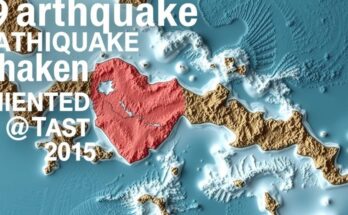Hurricane Rafael, having struck Cuba as a Category 3 storm, is now a Category 2 hurricane over the Gulf of Mexico. It caused extensive damage in Cuba, including knocked-out power and home collapses, with ongoing recovery efforts. Although expected to weaken, hazards from the storm persist as it moves west toward Mexico.
Hurricane Rafael, which previously impacted Cuba as a powerful Category 3 hurricane, has transitioned into a Category 2 storm while swirling over the Gulf of Mexico. On Friday, it was located approximately 230 miles north-northeast of Progreso, Mexico, with sustained winds reaching 110 mph (175 kph) and a northwest movement at 9 mph (15 kph). Although the storm is predicted to weaken significantly, it poses potential hazards due to swells and rip currents along the Gulf coast. Having struck Cuba on Wednesday, Hurricane Rafael demolished numerous homes, disrupted the power grid, and necessitated the evacuation of over 283,000 residents, leading to the collapse of at least 461 homes. In the aftermath, the Cuban government reported that power had been restored to around 143,000 homes in Havana, although many residents remained without electricity. Rafael’s effects were felt not only in Cuba but also in Jamaica and the Cayman Islands earlier in the week, where it disrupted lives and triggered mudslides. The recent onslaught of Hurricane Rafael compounded the difficulties faced by Cuba, which has already been experiencing significant energy crises marked by widespread blackouts. The disaster comes at a time when the country is struggling with infrastructure challenges and climate-related crises. While the storm is anticipated to lose strength as it continues over the Gulf, precautionary measures are still necessary to mitigate potential hazards associated with the lingering effects of this hurricane.
The dynamics of Hurricane Rafael highlight the increasing frequency and severity of tropical storms in the Caribbean, particularly as they relate to climate change and infrastructural vulnerabilities. The hurricane’s path through Cuba resulted in significant disruption, not only in terms of immediate damage but also with respect to the island’s ongoing energy crisis. The implications of such storms go beyond meteorological phenomena; they tap into broader discussions concerning disaster preparedness, recovery capacities, and the need for resilient infrastructure to withstand extreme weather events.
In summary, Hurricane Rafael has severely impacted Cuba, leading to significant infrastructural damage and energy challenges that compound the existing crises on the island. Despite being forecasted to weaken, the hurricane remains a threat in the Gulf of Mexico. This natural disaster underscores the need for improved disaster response and resilient infrastructure to withstand future severe weather events in the region.
Original Source: apnews.com




